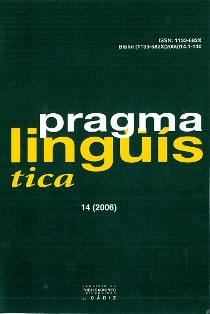Arabic verbless sentences is there a null VP?

DOI
https://doi.org/10.25267/Pragmalinguistica.2006.i14.07Información
Resumen
Este trabajo pretende describir y analizar el fenómeno de la ausencia de verbo copulativo en tiempo presente en las oraciones sin verbo en árabe. Por regla general, se asume que, en árabe, las oraciones sin verbo contienen un verbo copulativo nulo o elidido. Este estudio rebate dicho supuesto y propone que, en consonancia con las bases de la sintaxis minimista (expresadas inicialmente en Chomsky 1993, 1995), las oraciones sin verbo revelan ausencia de V y, por lo tanto, de VP. La razón es que la estructura objeto de estudio presenta dos posibilidades para expresar el tiempo presente: una mediante la ausencia de verbo, y otra que conlleva la presencia de verbo copulativo con flexión de tiempo.
Palabras clave
Descargas
Cómo citar
Licencia
Derechos de autor 2006 Pragmalingüística

Esta obra está bajo una licencia internacional Creative Commons Atribución-NoComercial-CompartirIgual 4.0.
Citas
ABU HIAN, A. (1377- AD), Ettatheel w Attkmeel,H. Hendawi (ed), 2001 Impression, Damascus, Dar Al-Kalm.
ABU MOSA, M. (1987), Delalat Atrakeeb, Cairo, Maktabt Wahbah.
AL-LIHEIBI, F. (1999), Aspects of Sentences Analysis in the Arabic Linguistic Tradition. Ph.D., thesis, University o f Durham. o f Durham.
Al-NASSIR, A. (1993), Sibawayh the phonologis, London & New York, Kegan Paul International.
BABBY, L. (1980), Existential Sentences and Negation in Russian, Ann Arbor: Michigan, Karoma.
BAHLOUL, M. (1994), “The Copula in Modern Standard Arabic”, in Holes C. & M. Eid (eds.) Perspectives on Arabic Linguistics V, Amsterdam, John Benjamins, 209-229. on Arabic Linguistics V, Amsterdam, John Benjamins, 209-229
BAKIR, M. (1980), Aspects of Clauses Structure in Arabic: A study of Word order variation in Literary Arabic, Ph.D. thesis, University of Indiana, Bloomington. (Circulated by Indiana University Linguistics Club, Bloomington, Indiana).
BASILICA, D. (2003), “The Topic of Small Clauses”, Linguistic Inquiry 34, 1-35.
BENMAMOUN, E. (2000), The feature Structure of Functional Categories: A Comparative Study of Arabic dialect, Oxford & New York, Oxford University Press.
BERGSTRASSER, G. (1997), Atatawor al-Nahwi li Alloghati al-Arabiahti. Translated from German into Arabic by R. Abdatawab, Cairo, Maktabt al-Khanji.
CHOMSKY, N. (1995), The Minimalist Program, Cambridge MA, MIT Press.
CHOMSKY, N. (2000), “Minimalist inquiries”,inMartin R., D. Michaels & J. Uriagereka (eds.), Step by step:Essays on minimalism in honor of Lasnik Howard, Cambridge, Mass, MIT Press, 83-155.
DORON, E. (1986), “The Pronominal Copula as Agreement Clitic”, in Borer H. (ed), Syntax of Pronominal Clitics, New York, Academic Press,313-332.
DUKHAYYIL, J. (2004), “Ziadt kana”, Journal of King Saud University in Saudi Arabia, 17:27-53.
EID, M. (1991), “VerblessSentences in Arabic and Hebrew”, in Comrie B. & M. Eid (eds.), Perspectives on Arabic Linguistics III, 31-61.Perspectives on Arabic Linguistics III, 31-61.
ELDER, E (1950), Arabic Grammar: Inductive Method, Cairo, Elias Modern Press.
FALK, Y. (2004), “The Hebrew Present Tense Copula as a Mixed Category en Butt M. & T. Holloway King (eds), Proceedings of the LFG 04 Conference, University of Canterbury, On-line: CSLI Publications, 226-246.
FASSI FEHRI, A. (1993), Issues in the Structure of Arabic Clauses and Words. Dordrecht, Kluwer.
HASAN, A. (1970), Al-nahwo Al-Wafi , Cairo, Dar al-Maaref.
HAYWOOD, J and H, NAHMAD. (1995), A new Arabic Grammar of the Written Language, London, Lund Humphries.
IBN HESHAM, J. (1590- AD), Awdaho al-Masalik. vol 1,(1994) impression,Beirut, Dar al-fi kr.
IBN JINNI, A. (1002-AD), Sirr Sinaat al-Iarab, Hendawi H. (ed), (1993) impression, Damascus: Dar Al-Qalm.
LABOV, W. (1995), “The case of the missing copula: the interpretation of zeros in African American English”, in Gleitman L. & M. Liberman (eds.), Language. An Invitation to Cognitive Science, 1, 25-54.
MILLER, C. (1999), “Pivotal Issues in Analyzing the Verbless Clause in The verbless Clause”, in Miller Cynthia L. (ed), Biblical Hebrew: linguistic approaches, 1, 3-17, Winona Lake, Indiana, Eisenbrauns.
RADFORD, A. (2004), Minimalist Syntax: Exploring the structure of English. Cambridge, Cambridge University Press.
SHLONSKY, Ur. (1997), Clause Structure and Word Order in Hebrew and Arabic: An Essay in comparative Semitic Syntax. Oxford & New York, Oxford University Press.
SIBAWAYH, A. (741-AD), Al-Kitaab, (1977) impression, Cairo, Dar Al-Qalam Press.






